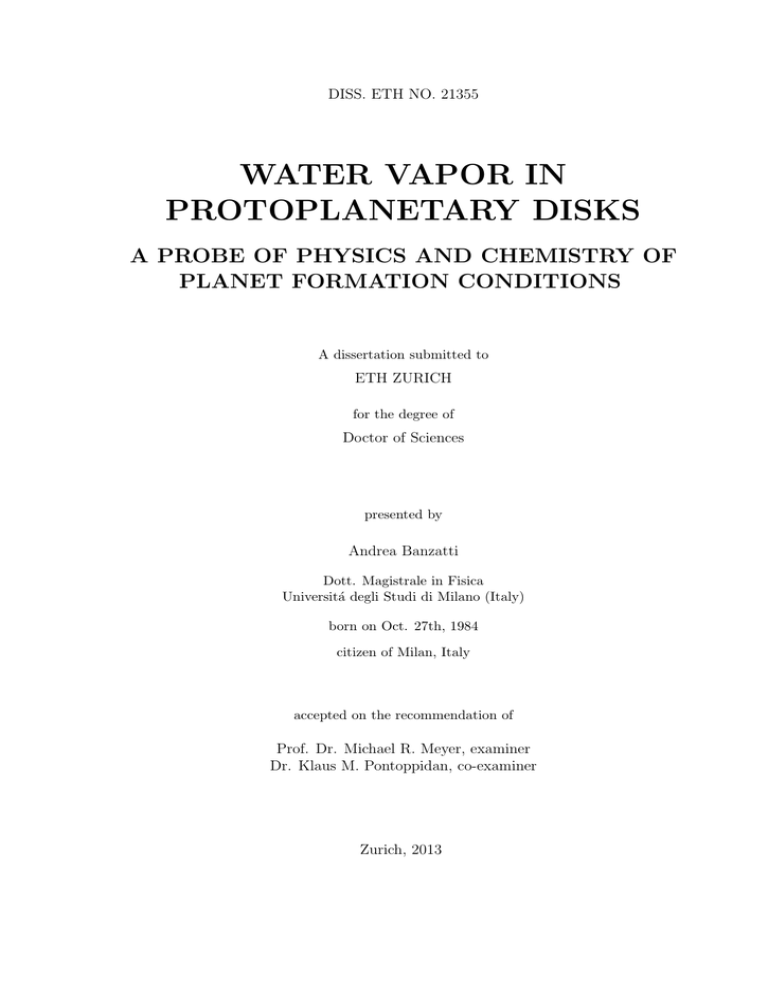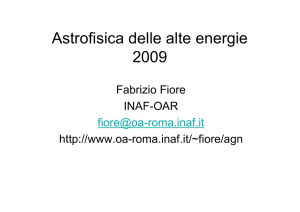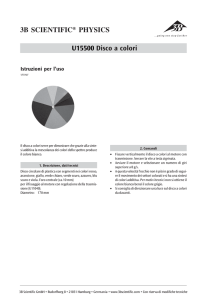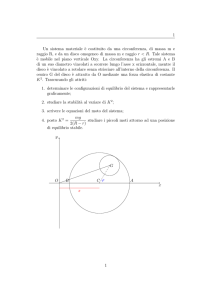
DISS. ETH NO. 21355
WATER VAPOR IN
PROTOPLANETARY DISKS
A PROBE OF PHYSICS AND CHEMISTRY OF
PLANET FORMATION CONDITIONS
A dissertation submitted to
ETH ZURICH
for the degree of
Doctor of Sciences
presented by
Andrea Banzatti
Dott. Magistrale in Fisica
Universitá degli Studi di Milano (Italy)
born on Oct. 27th, 1984
citizen of Milan, Italy
accepted on the recommendation of
Prof. Dr. Michael R. Meyer, examiner
Dr. Klaus M. Pontoppidan, co-examiner
Zurich, 2013
Abstract
This thesis is devoted to a study of the conditions and evolution of the terrestrial
planet formation region in young circumstellar disks (disk radii ≈ 1–10 AU from
the central star), by means of spectroscopic observations of molecular gas emission.
The main focus of this work is the infrared spectrum of water (H2 O), which provides
thousands of emission lines tracing the warm and dense gas inward of the snowline in
disks. Aside from that, the analysis includes emission from some organic molecules
that trace the carbon chemistry, C2 H2 (acetylene), HCN (hydrogen cyanide), and
CO2 (carbon dioxide), as well as emission from OH (hydroxyl) that is connected to
the formation and destruction of the water molecule. Particular consideration in
this work is given to variable accretion phenomena occurring during the T Tauri
phase of young stellar objects, which are used as a tool to better understand the
origin and evolution of the molecular gas in inner disks.
A pioneering contribution of this work is the study of the change in molecular gas
emission observed toward the strongly variable T Tauri star EX Lupi (Chapter 2
in this book). Mid-infrared spectra obtained previous to and during a recent accretion outburst were compared, and found that the gas emission changes remarkably
between the two phases. The spectrum in quiescence is composed of the typical
molecular lines that dominate mid-infrared spectra of T Tauri systems, showing a
dense forest of lines from water, OH, C2 H2 , HCN, and CO2 . These lines are observed in emission and attributed to warm gas layers at a few AU in the disk from
the central star. In outburst, water emission increases in strength, new OH lines
are detected, and emission from organics disappears. These changes have been interpreted as due to a larger emitting area of the warm gas in outburst (probably
linked to a recession of the snowline), when the disk temperature increases after the
increase in accretion luminosity from the star. In addition, enhanced UV radiation
is found to produce OH from photodissociation of water. The behavior of organics
remains unclear from the limited set of data used in this study, but could be due
to changes in excitation, chemistry, or both. All molecular emissions are difficult to
analyze and interpret, because of strong blending between individual lines (from the
iii
ABSTRACT
same as well as different molecules). This is particularly true for water, which has
thousands of lines scattered all over the infrared range. Encountering this complexity motivated a careful analysis and a detailed modeling with particular attention
to the applicability of slab models that assume thermal equilibrium for the observed
emission.
The remarkable findings of this study motivated follow-up investigations in two
directions. One direction was taken to better understand the role of accretion variability in shaping the conditions of the molecular gas in inner disks during the
T Tauri phase. A new-concept monitoring program was performed observing the
T Tauri system DR Tau with two high spectral resolution spectrographs at the
ESO Very Large Telescope (Chapter 3 in this book). VISIR (resolving power R =
20000) was used to resolve two individual mid-infrared water lines from the disk,
while X-shooter (R = 9000–17000) was used to simultaneously monitor the UV–NIR
spectrum (0.3–2.5 µm) and measure changes in accretion luminosity. Three epochs
of simultaneous observations were successfully taken, where the accretion luminosity
onto the star changed to within a factor of 2 (decreasing in the second epoch, increasing in the third). Water emission from the disk was found to be stable (within
10%) over these three epochs, in contrast with the increase in water emission observed in EX Lupi for a change in accretion luminosity of a factor 40. Comparison of
DR Tau and EX Lupi suggests a scenario where variable accretion phenomena have
two effects on the inner disk: one is to heat the disk, but considerable variations
can be produced only when the accretion keeps higher over long enough timescales
for the thermal structure of the disk to change (& weeks, as in EX Lupi). A second effect is to photodissociate water by means of UV radiation, which is the main
component of the accretion luminosity spectrum. This latter process is very fast
and probably dominates the changes in molecular emission during the short-term
accretion variability typically found in the T Tauri phase.
A second direction was taken to tackle another fundamental problem: the origin
of water vapor and its connection to processes happening inside disks. Competing
theories provide two different perspectives, where water is produced by evaporation
of icy solids migrating inward of the snowline, or formed in situ via gas-phase reactions. It is important to distinguish which process dominates in order to understand
what we learn from observing (or not observing) water vapor in inner disks. One
way to do that is by measuring the abundance of water vapor in the inner disk,
and compare it to the oxygen abundance available to form water in situ (typically
assumed to be solar). In this thesis, for the first time, a systematic rotation diagram analysis has been applied to infrared water emission (Chapter 4 in this book).
The analysis established a link between the spread of the rotational scatter and the
water abundance in the inner disk, where a large rotational scatter would provide
evidence for the migration scenario. A de-blending procedure was developed to extract a large number of emission lines from a dozen of high signal-to-noise Spitzer
spectra of protoplanetary disks, so to attempt a comprehensive interpretation of the
observed emission. Large rotational scatters are indeed observed in some of these
iv
disks, supporting water vapor enrichment from evaporation of icy migrators, but the
intrinsic limitation of the Spitzer data allows us to provide only a tentative confirmation. Measurement of resolved optically thin lines within the forest of optically
thick lines is proposed to be a key tool to address the (still open) question, and
future higher-resolution observations will provide important answers on the origin
of water vapor and its connection to disk evolution and planet formation processes.
v
Riassunto
Questa tesi è dedicata allo studio delle condizioni e dell’evoluzione della regione di
formazione dei pianeti terrestri in giovani dischi circumstellari (a raggi di 1–10 AU
nel disco), per mezzo di osservazioni spettroscopiche di emissione gassosa. Questo
lavoro si focalizza principalmente sullo spettro infrarosso del vapore acqueo (H2 O),
che fornisce migliaia di righe di emissione dal gas caldo e denso presente nelle regioni
interne dei dischi. Assieme a questo, l’analisi include lo studio dell’emissione di alcune molecole organiche, C2 H2 (acetilene), HCN (acido cianidrico), e CO2 (anidride
carbonica), cosı̀ come l’emissione di OH (ossidrile), che è collegato alla formazione
e distruzione della molecola d’acqua. Particolare attenzione viene data ai fenomeni
di accrescimento non costante durante la fase T Tauri di oggetti stellari giovani, che
vengono utilizzati come strumento per comprendere meglio l’origine e l’evoluzione
del gas molecolare nei dischi.
Un contributo pionieristico di questo lavoro è lo studio della variazione di emissione di gas molecolare osservata verso la stella EX Lupi, una T Tauri fortemente
variabile. Spettri nel medio infrarosso ottenuti precedentemente e durante un recente
forte aumento d’accrescimento sono stati confrontati, trovando che il gas cambia
notevolmente tra le due fasi. L’emissione in quiescenza è composta da righe molecolari che tipicamente dominano lo spettro di sistemi T Tauri nel medio infrarosso,
mostrando una fitta foresta di righe d’acqua, OH, C2 H2 , HCN, e CO2 . Queste
righe sono osservate in emissione e sono attribuite a strati di gas caldo nel disco,
ad alcune AU dalla stella centrale. Durante l’aumento di accrescimento, l’emissione
d’acqua diventa piú intensa, nuove righe di OH sono detettate, e l’emissione da
sostanze organiche scompare. Queste alterazioni sono interpretate come dovute a
una più estesa area di gas caldo, quando il riscaldamento del disco aumenta per
l’aumento dell’accrescimento. Inoltre, una maggiore radiazione UV svolge un ruolo
chiave nella produzione di OH da fotodissociazione di acqua. Il comportamento
delle sostanze organiche è reso poco chiaro dai limiti dei dati utilizzati in questo
studio, ma potrebbe essere dovuto a variazioni in eccitazione, chimica, o entrambe.
vii
RIASSUNTO
Tutte le emissioni molecolari sono difficili da analizzare, a causa della forte confusione tra righe individuali. Ciò è particolarmente vero per l’acqua, che ha migliaia
di righe sparse su tutto l’infrarosso e per cui modelli semplici in equilibrio termico
locale possono solo approssimativamente riprodurre l’emissione (suggerendo effetti
non termici nell’eccitazione).
I notevoli risultati di questo studio hanno motivato indagini successive in due direzioni. Una direzione è stata presa per comprendere meglio il ruolo della variabilità
di accrescimento nel modellare le condizioni del gas molecolare nei dischi durante la
fase T Tauri. Un monitoraggio di nuova concezione è stato effettuato osservando il
sistema T Tauri DR Tau con due spettrografi ad alta risoluzione spettrale del Very
Large Telescope (VLT) dell’ESO. VLT / VISIR (con risoluzione spettrale R = 20000)
è stato utilizzato per risolvere le singole righe d’acqua nel medio infrarosso, mentre
VLT / X-shooter (R = 9.000–17.000) è stato utilizzato per monitorare contemporaneamente l’UV–NIR (0.3–2.5 µm) e le variazioni in luminosità d’accrescimento.
Tre epoche di osservazioni simultanee sono state prese con successo, ma purtroppo
l’accrescimento non è cambiato notevolmente (solo di un fattore 2). Una leggera
tendenza è stata vista nell’emissione d’acqua, mostrando righe più deboli per una
maggiore luminosità di accrescimento, ma il cambiamento è stato troppo basso per
essere significativo al di sopra del rumore. Questa ulteriore indagine ha potuto affrontare solo una piccola parte delle questioni sollevate dallo studio di EX Lupi,
ma ha permesso di focalizzare meglio una prospettiva interessante. Le analisi di
questi due sistemi, combinate, sono coerenti con uno scenario in cui i fenomeni
di accrescimento non-stazionario hanno due effetti sul disco interno: uno è quello
di riscaldare il disco, ma notevoli variazioni possono essere prodotte solo quando
l’accrescimento aumenta su scale temporali abbastanza lunghe perché la struttura
termica del disco possa cambiare (& mesi, come in EX Lupi). Un secondo effetto è
quello di fotodissociare acqua per mezzo di radiazioni UV, che sono la componente
principale della luminosità d’accrescimento. Quest’ultimo processo è molto veloce e
probabilmente domina le variazioni di emissione molecolare nelle fasi di rapida variabilità d’accrescimento tipicamente trovate nei sistemi T Tauri. Una ulteriore epoca
di osservazioni su DR Tau sarebbe sufficiente per confermare (o smentire) questo
scenario, nel momento in cui cambiamenti in accrescimento di almeno un fattore 4
avvenissero.
Una seconda direzione è stata presa per affrontare un altro problema fondamentale, l’origine del vapore acqueo nei dischi protoplanetari e la connessione con la loro
evoluzione. La molecola d’acqua in stato gassoso viene attribuita a processi fondamentali che avvengono nel disco. Teorie in competizione offrono due prospettive
diverse, in cui l’acqua è dovuta a evaporazione di solidi ghiacciati che migrano verso
l’interno del disco, o formata in loco tramite reazioni nel gas. Mentre la migrazione
e l’evaporazione di solidi ghiacciati farebbero dell’emissione d’acqua un buon tracciante dell’evoluzione del disco e delle condizioni di formazione dei pianeti, la formazione in loco in un disco statico fornirebbe solo informazioni locali sull’atmosfera
del disco, che può essere o meno collegata a ciò che accade negli strati più profondi.
viii
È quindi essenziale distinguere quale processo domini per capire cosa impariamo dal
detettare (o non detettare) vapore acqueo nei dischi. Un modo per farlo è quello di
misurare l’abbondanza di vapore acqueo nel disco interno, in grado di fornire la prova
di arricchimento dal disco esterno prodotto da evaporazione di migratori di ghiaccio. In questa tesi, per la prima volta, un’analisi sistematica tramite diagramma di
rotazione è stata applicata all’emissione d’acqua su un campione considerevole di
giovani dischi circumstellari. Una procedura è stata sviluppata per estrarre un gran
numero di righe di emissione da spettri non risolti, cosı̀ da consentire una comprensione più completa dell’emissione osservata. L’analisi ha indicato la possibilità di
densità superficiali d’acqua piú grandi di quanto si pensasse, il che potrebbe essere
interpretato come una prova dello scenario migratorio. Tuttavia, l’attuale stato di
dati e modelli non permette di trarre forti conclusioni, soprattutto per la degenerazione tra abbondanza d’acqua e il rapporto tra gas e polvere assunti nei modelli.
Misura di righe otticamente sottili risolte all’interno della foresta di righe otticamente spesse viene proposto essere uno strumento fondamentale per affrontare la
questione (ancora aperta), e osservazioni future a più alta risoluzione potrebbero
fornire risposte importanti sull’origine del vapore acqueo e sulla sua connessione con
l’evoluzione del disco.
ix










